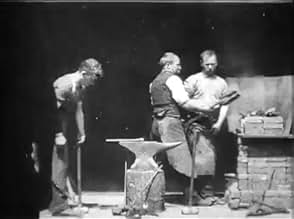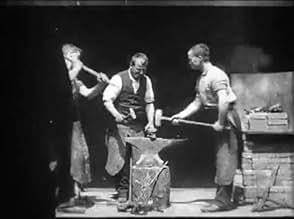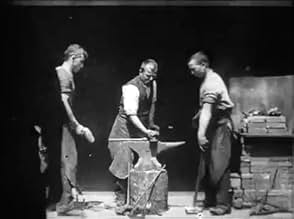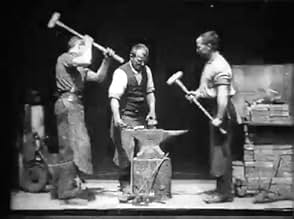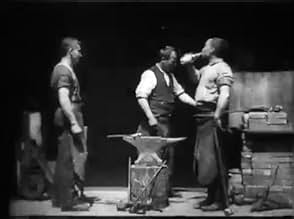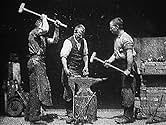Ajouter une intrigue dans votre langueThree men hammer on an anvil and pass a bottle of beer around.Three men hammer on an anvil and pass a bottle of beer around.Three men hammer on an anvil and pass a bottle of beer around.
- Réalisation
- Casting principal
- Récompenses
- 1 victoire au total
Charles Kayser
- Blacksmith
- (non crédité)
Avis à la une
Very similar to Newark Athlete, but this time the clip runs much more smoothly. Nothing jerks, and there's only one cut. The mixing of alcohol and work also makes this slightly comical.
All right, so it's short on plot. But just the fact of this Edison-studio produced film is enough to make it an award-winner. It doesn't have the same pathos as the Edison clip of men dancing used to such great effect in "The Celluloid Closet," but how can you not love a century-old example of "Miller Time"?
The Black Maria movie studio at Edison's West Orange, New Jersey laboratory (see comments on "Men Boxing" for a description) was used, from 1892 until 1900, to produce as many as 300 films. "Blacksmith Scene" was filmed in this studio and is generally regarded as the earliest known commercial film. It was filmed by the vertical-feed Kinetograph camera using 1-1/2-inch celluloid film newly developed by the Eastman Company.
To make this film 'commercial', it was necessary to have a way for the public to view it. A Kinetoscope was developed for that purpose. The Kinetoscope (a peep-show machine) was used for a public exhibition; given at a meeting of the Brooklyn Institute of Arts and Sciences on Tuesday May 9th, 1893. Over 400 people lined up to view the film over a two hour period.
To make this film 'commercial', it was necessary to have a way for the public to view it. A Kinetoscope was developed for that purpose. The Kinetoscope (a peep-show machine) was used for a public exhibition; given at a meeting of the Brooklyn Institute of Arts and Sciences on Tuesday May 9th, 1893. Over 400 people lined up to view the film over a two hour period.
This is supposed to be the "first staged narrative in film", although it is really better described as one of the "actualities" that Edison's films were known as, and what ultimately, about 20 years later, was their downfall. Actualities really had no story, they were just glimpses into normal life, and sometimes the weird and fanciful, but none really had a story.
Apparently the guy in the middle is an actual blacksmith and the two assistants are actors. Together they hammer on a heated rod placed on an anvil. Afterwards, the three share a bottle of beer. Both actors had long lives. One lived from 1850-1931. The other, Charles Kayser, lived from 1878-1966, which would have made him only fifteen when this film was made. So he would have lived to see movies grow from these actualities, to features, the coming of sound, then TV, then even color TV.
Apparently the guy in the middle is an actual blacksmith and the two assistants are actors. Together they hammer on a heated rod placed on an anvil. Afterwards, the three share a bottle of beer. Both actors had long lives. One lived from 1850-1931. The other, Charles Kayser, lived from 1878-1966, which would have made him only fifteen when this film was made. So he would have lived to see movies grow from these actualities, to features, the coming of sound, then TV, then even color TV.
It's always fascinating to watch movies that are this old because it's like looking a hundred years into the past. You get to see a glimpse of what the world was like a century ago, even though in this particular film all we see is three guys hammering on an anvil. Blacksmith Scene was the first film ever to be shown to a large audience, I think it was something like 200 people who watched it one at a time on a kinetoscope after a lecture by the Edison Company, the creators of the film. Actual projection of movies didn't start until about a year or so later.
There are a lot of interesting things about this film, especially since it's the first one that was made to be shown to a large audience. These are actors in the film, not actual blacksmiths, so it's not even a documentary but it's interesting that the first thing portrayed is actual work. A perfect way to introduce a new medium. Another thing that is pretty interesting is the way they pass around that bottle of beer - even in this earliest of early films, they are striving to entertain. This is not just a moving photograph, but a primitive film that seeks to do exactly what every film made thereafter strives to do - hold the audience's attention. Obviously, it was a lot easier for a moving picture to hold the audience's attention in 1893 than it is today, but in this primitive film all of the major requirements of a film can be found.
Except a plot, of course...
There are a lot of interesting things about this film, especially since it's the first one that was made to be shown to a large audience. These are actors in the film, not actual blacksmiths, so it's not even a documentary but it's interesting that the first thing portrayed is actual work. A perfect way to introduce a new medium. Another thing that is pretty interesting is the way they pass around that bottle of beer - even in this earliest of early films, they are striving to entertain. This is not just a moving photograph, but a primitive film that seeks to do exactly what every film made thereafter strives to do - hold the audience's attention. Obviously, it was a lot easier for a moving picture to hold the audience's attention in 1893 than it is today, but in this primitive film all of the major requirements of a film can be found.
Except a plot, of course...
Le saviez-vous
- AnecdotesThe mixing of work and alcohol was commonplace in the early 19th century, especially amongst heavy laborers. By the 1890's, however, the practice had died away. The use of the bottle of beer in this film is intended to invoke a sense of comic nostalgia of a bygone era.
- ConnexionsFeatured in Edison: The Invention of the Movies (2005)
Meilleurs choix
Connectez-vous pour évaluer et suivre la liste de favoris afin de recevoir des recommandations personnalisées
Détails
- Durée1 minute
- Couleur
- Mixage
- Rapport de forme
- 1.33 : 1
Contribuer à cette page
Suggérer une modification ou ajouter du contenu manquant

